创建grpc服务
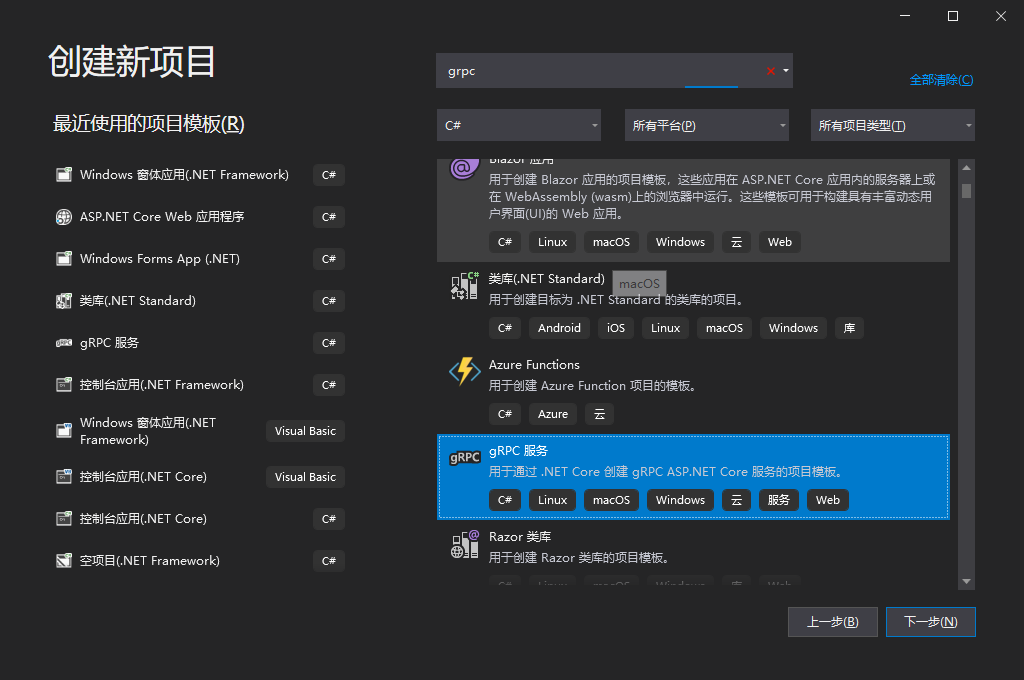
运行项目

创建client
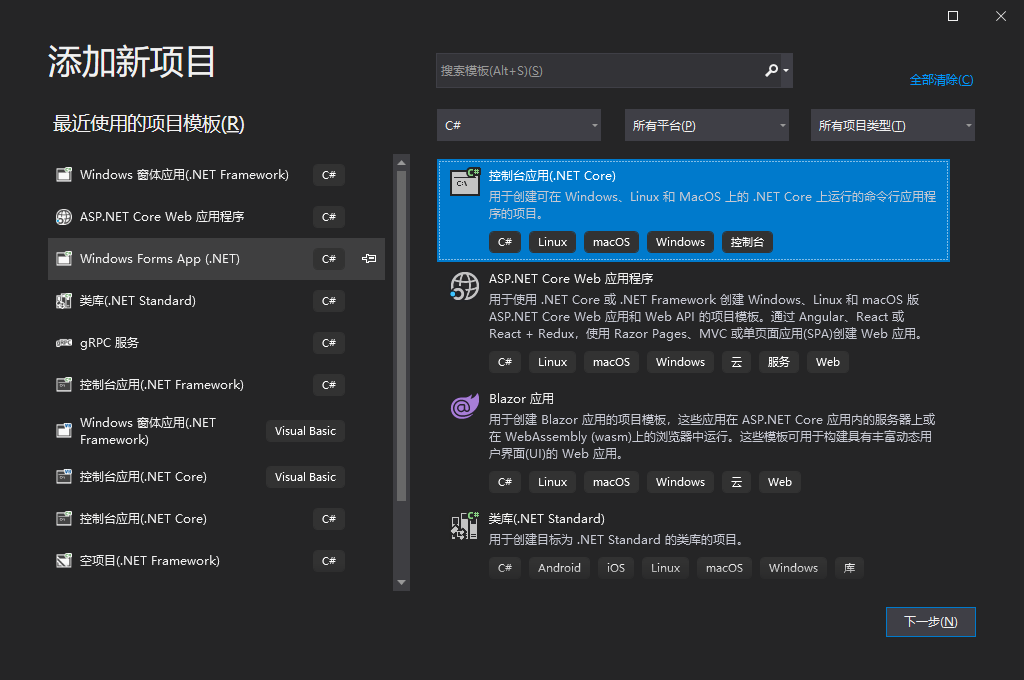
添加nuget : Google.Protobuf ,Grpc.Net.Client , Grpc.Tools

创建Protos文件夹,然后把service项目下的greet.proto文件复制过来,并更改scharp_namespace

更改文件的属性如下
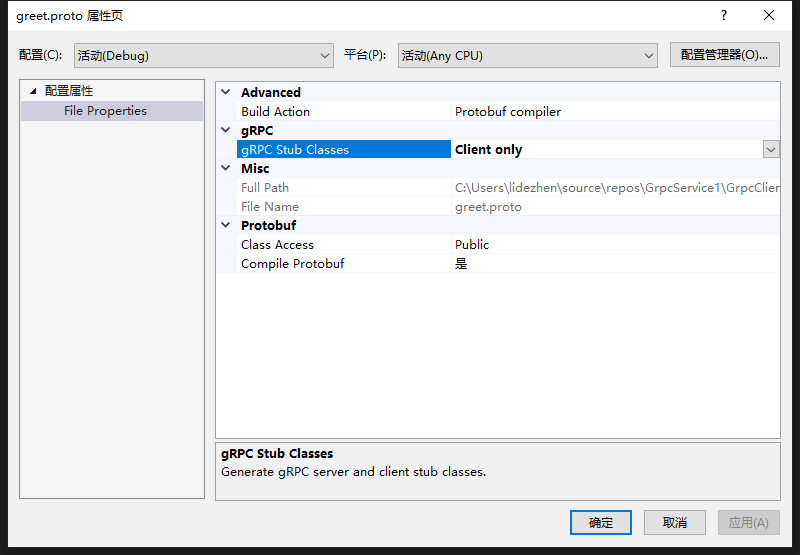
然后再main函数添加调用代码
using var channel = GrpcChannel.ForAddress("https://localhost:5001");
var client = new Greeter.GreeterClient(channel);
var reply = client.SayHelloAsync(
new HelloRequest { Name = "李德镇" }).GetAwaiter().GetResult();
Console.WriteLine("Greeting: " + reply.Message);
Console.ReadKey();
先运行service 再运行client

现在服务端和客户端都可以运行起来了,下一步将添加自动生成webapi功能
添加nuget包

使用 AddGrpcHttpApi 在 Startup.cs 中注册服务
添加文件夹google和子文件夹api

添加http.proto

// Copyright 2019 Google LLC. // // Licensed under the Apache License, Version 2.0 (the "License"); // you may not use this file except in compliance with the License. // You may obtain a copy of the License at // // http://www.apache.org/licenses/LICENSE-2.0 // // Unless required by applicable law or agreed to in writing, software // distributed under the License is distributed on an "AS IS" BASIS, // WITHOUT WARRANTIES OR CONDITIONS OF ANY KIND, either express or implied. // See the License for the specific language governing permissions and // limitations under the License. // syntax = "proto3"; package google.api; option cc_enable_arenas = true; option go_package = "google.golang.org/genproto/googleapis/api/annotations;annotations"; option java_multiple_files = true; option java_outer_classname = "HttpProto"; option java_package = "com.google.api"; option objc_class_prefix = "GAPI"; // Defines the HTTP configuration for an API service. It contains a list of // [HttpRule][google.api.HttpRule], each specifying the mapping of an RPC method // to one or more HTTP REST API methods. message Http { // A list of HTTP configuration rules that apply to individual API methods. // // **NOTE:** All service configuration rules follow "last one wins" order. repeated HttpRule rules = 1; // When set to true, URL path parameters will be fully URI-decoded except in // cases of single segment matches in reserved expansion, where "%2F" will be // left encoded. // // The default behavior is to not decode RFC 6570 reserved characters in multi // segment matches. bool fully_decode_reserved_expansion = 2; } // # gRPC Transcoding // // gRPC Transcoding is a feature for mapping between a gRPC method and one or // more HTTP REST endpoints. It allows developers to build a single API service // that supports both gRPC APIs and REST APIs. Many systems, including [Google // APIs](https://github.com/googleapis/googleapis), // [Cloud Endpoints](https://cloud.google.com/endpoints), [gRPC // Gateway](https://github.com/grpc-ecosystem/grpc-gateway), // and [Envoy](https://github.com/envoyproxy/envoy) proxy support this feature // and use it for large scale production services. // // `HttpRule` defines the schema of the gRPC/REST mapping. The mapping specifies // how different portions of the gRPC request message are mapped to the URL // path, URL query parameters, and HTTP request body. It also controls how the // gRPC response message is mapped to the HTTP response body. `HttpRule` is // typically specified as an `google.api.http` annotation on the gRPC method. // // Each mapping specifies a URL path template and an HTTP method. The path // template may refer to one or more fields in the gRPC request message, as long // as each field is a non-repeated field with a primitive (non-message) type. // The path template controls how fields of the request message are mapped to // the URL path. // // Example: // // service Messaging { // rpc GetMessage(GetMessageRequest) returns (Message) { // option (google.api.http) = { // get: "/v1/{name=messages/*}" // }; // } // } // message GetMessageRequest { // string name = 1; // Mapped to URL path. // } // message Message { // string text = 1; // The resource content. // } // // This enables an HTTP REST to gRPC mapping as below: // // HTTP | gRPC // -----|----- // `GET /v1/messages/123456` | `GetMessage(name: "messages/123456")` // // Any fields in the request message which are not bound by the path template // automatically become HTTP query parameters if there is no HTTP request body. // For example: // // service Messaging { // rpc GetMessage(GetMessageRequest) returns (Message) { // option (google.api.http) = { // get:"/v1/messages/{message_id}" // }; // } // } // message GetMessageRequest { // message SubMessage { // string subfield = 1; // } // string message_id = 1; // Mapped to URL path. // int64 revision = 2; // Mapped to URL query parameter `revision`. // SubMessage sub = 3; // Mapped to URL query parameter `sub.subfield`. // } // // This enables a HTTP JSON to RPC mapping as below: // // HTTP | gRPC // -----|----- // `GET /v1/messages/123456?revision=2&sub.subfield=foo` | // `GetMessage(message_id: "123456" revision: 2 sub: SubMessage(subfield: // "foo"))` // // Note that fields which are mapped to URL query parameters must have a // primitive type or a repeated primitive type or a non-repeated message type. // In the case of a repeated type, the parameter can be repeated in the URL // as `...?param=A¶m=B`. In the case of a message type, each field of the // message is mapped to a separate parameter, such as // `...?foo.a=A&foo.b=B&foo.c=C`. // // For HTTP methods that allow a request body, the `body` field // specifies the mapping. Consider a REST update method on the // message resource collection: // // service Messaging { // rpc UpdateMessage(UpdateMessageRequest) returns (Message) { // option (google.api.http) = { // patch: "/v1/messages/{message_id}" // body: "message" // }; // } // } // message UpdateMessageRequest { // string message_id = 1; // mapped to the URL // Message message = 2; // mapped to the body // } // // The following HTTP JSON to RPC mapping is enabled, where the // representation of the JSON in the request body is determined by // protos JSON encoding: // // HTTP | gRPC // -----|----- // `PATCH /v1/messages/123456 { "text": "Hi!" }` | `UpdateMessage(message_id: // "123456" message { text: "Hi!" })` // // The special name `*` can be used in the body mapping to define that // every field not bound by the path template should be mapped to the // request body. This enables the following alternative definition of // the update method: // // service Messaging { // rpc UpdateMessage(Message) returns (Message) { // option (google.api.http) = { // patch: "/v1/messages/{message_id}" // body: "*" // }; // } // } // message Message { // string message_id = 1; // string text = 2; // } // // // The following HTTP JSON to RPC mapping is enabled: // // HTTP | gRPC // -----|----- // `PATCH /v1/messages/123456 { "text": "Hi!" }` | `UpdateMessage(message_id: // "123456" text: "Hi!")` // // Note that when using `*` in the body mapping, it is not possible to // have HTTP parameters, as all fields not bound by the path end in // the body. This makes this option more rarely used in practice when // defining REST APIs. The common usage of `*` is in custom methods // which don't use the URL at all for transferring data. // // It is possible to define multiple HTTP methods for one RPC by using // the `additional_bindings` option. Example: // // service Messaging { // rpc GetMessage(GetMessageRequest) returns (Message) { // option (google.api.http) = { // get: "/v1/messages/{message_id}" // additional_bindings { // get: "/v1/users/{user_id}/messages/{message_id}" // } // }; // } // } // message GetMessageRequest { // string message_id = 1; // string user_id = 2; // } // // This enables the following two alternative HTTP JSON to RPC mappings: // // HTTP | gRPC // -----|----- // `GET /v1/messages/123456` | `GetMessage(message_id: "123456")` // `GET /v1/users/me/messages/123456` | `GetMessage(user_id: "me" message_id: // "123456")` // // ## Rules for HTTP mapping // // 1. Leaf request fields (recursive expansion nested messages in the request // message) are classified into three categories: // - Fields referred by the path template. They are passed via the URL path. // - Fields referred by the [HttpRule.body][google.api.HttpRule.body]. They are passed via the HTTP // request body. // - All other fields are passed via the URL query parameters, and the // parameter name is the field path in the request message. A repeated // field can be represented as multiple query parameters under the same // name. // 2. If [HttpRule.body][google.api.HttpRule.body] is "*", there is no URL query parameter, all fields // are passed via URL path and HTTP request body. // 3. If [HttpRule.body][google.api.HttpRule.body] is omitted, there is no HTTP request body, all // fields are passed via URL path and URL query parameters. // // ### Path template syntax // // Template = "/" Segments [ Verb ] ; // Segments = Segment { "/" Segment } ; // Segment = "*" | "**" | LITERAL | Variable ; // Variable = "{" FieldPath [ "=" Segments ] "}" ; // FieldPath = IDENT { "." IDENT } ; // Verb = ":" LITERAL ; // // The syntax `*` matches a single URL path segment. The syntax `**` matches // zero or more URL path segments, which must be the last part of the URL path // except the `Verb`. // // The syntax `Variable` matches part of the URL path as specified by its // template. A variable template must not contain other variables. If a variable // matches a single path segment, its template may be omitted, e.g. `{var}` // is equivalent to `{var=*}`. // // The syntax `LITERAL` matches literal text in the URL path. If the `LITERAL` // contains any reserved character, such characters should be percent-encoded // before the matching. // // If a variable contains exactly one path segment, such as `"{var}"` or // `"{var=*}"`, when such a variable is expanded into a URL path on the client // side, all characters except `[-_.~0-9a-zA-Z]` are percent-encoded. The // server side does the reverse decoding. Such variables show up in the // [Discovery // Document](https://developers.google.com/discovery/v1/reference/apis) as // `{var}`. // // If a variable contains multiple path segments, such as `"{var=foo/*}"` // or `"{var=**}"`, when such a variable is expanded into a URL path on the // client side, all characters except `[-_.~/0-9a-zA-Z]` are percent-encoded. // The server side does the reverse decoding, except "%2F" and "%2f" are left // unchanged. Such variables show up in the // [Discovery // Document](https://developers.google.com/discovery/v1/reference/apis) as // `{+var}`. // // ## Using gRPC API Service Configuration // // gRPC API Service Configuration (service config) is a configuration language // for configuring a gRPC service to become a user-facing product. The // service config is simply the YAML representation of the `google.api.Service` // proto message. // // As an alternative to annotating your proto file, you can configure gRPC // transcoding in your service config YAML files. You do this by specifying a // `HttpRule` that maps the gRPC method to a REST endpoint, achieving the same // effect as the proto annotation. This can be particularly useful if you // have a proto that is reused in multiple services. Note that any transcoding // specified in the service config will override any matching transcoding // configuration in the proto. // // Example: // // http: // rules: // # Selects a gRPC method and applies HttpRule to it. // - selector: example.v1.Messaging.GetMessage // get: /v1/messages/{message_id}/{sub.subfield} // // ## Special notes // // When gRPC Transcoding is used to map a gRPC to JSON REST endpoints, the // proto to JSON conversion must follow the [proto3 // specification](https://developers.google.com/protocol-buffers/docs/proto3#json). // // While the single segment variable follows the semantics of // [RFC 6570](https://tools.ietf.org/html/rfc6570) Section 3.2.2 Simple String // Expansion, the multi segment variable **does not** follow RFC 6570 Section // 3.2.3 Reserved Expansion. The reason is that the Reserved Expansion // does not expand special characters like `?` and `#`, which would lead // to invalid URLs. As the result, gRPC Transcoding uses a custom encoding // for multi segment variables. // // The path variables **must not** refer to any repeated or mapped field, // because client libraries are not capable of handling such variable expansion. // // The path variables **must not** capture the leading "/" character. The reason // is that the most common use case "{var}" does not capture the leading "/" // character. For consistency, all path variables must share the same behavior. // // Repeated message fields must not be mapped to URL query parameters, because // no client library can support such complicated mapping. // // If an API needs to use a JSON array for request or response body, it can map // the request or response body to a repeated field. However, some gRPC // Transcoding implementations may not support this feature. message HttpRule { // Selects a method to which this rule applies. // // Refer to [selector][google.api.DocumentationRule.selector] for syntax details. string selector = 1; // Determines the URL pattern is matched by this rules. This pattern can be // used with any of the {get|put|post|delete|patch} methods. A custom method // can be defined using the 'custom' field. oneof pattern { // Maps to HTTP GET. Used for listing and getting information about // resources. string get = 2; // Maps to HTTP PUT. Used for replacing a resource. string put = 3; // Maps to HTTP POST. Used for creating a resource or performing an action. string post = 4; // Maps to HTTP DELETE. Used for deleting a resource. string delete = 5; // Maps to HTTP PATCH. Used for updating a resource. string patch = 6; // The custom pattern is used for specifying an HTTP method that is not // included in the `pattern` field, such as HEAD, or "*" to leave the // HTTP method unspecified for this rule. The wild-card rule is useful // for services that provide content to Web (HTML) clients. CustomHttpPattern custom = 8; } // The name of the request field whose value is mapped to the HTTP request // body, or `*` for mapping all request fields not captured by the path // pattern to the HTTP body, or omitted for not having any HTTP request body. // // NOTE: the referred field must be present at the top-level of the request // message type. string body = 7; // Optional. The name of the response field whose value is mapped to the HTTP // response body. When omitted, the entire response message will be used // as the HTTP response body. // // NOTE: The referred field must be present at the top-level of the response // message type. string response_body = 12; // Additional HTTP bindings for the selector. Nested bindings must // not contain an `additional_bindings` field themselves (that is, // the nesting may only be one level deep). repeated HttpRule additional_bindings = 11; } // A custom pattern is used for defining custom HTTP verb. message CustomHttpPattern { // The name of this custom HTTP verb. string kind = 1; // The path matched by this custom verb. string path = 2; }
添加annotations.proto

// Copyright (c) 2015, Google Inc. // // Licensed under the Apache License, Version 2.0 (the "License"); // you may not use this file except in compliance with the License. // You may obtain a copy of the License at // // http://www.apache.org/licenses/LICENSE-2.0 // // Unless required by applicable law or agreed to in writing, software // distributed under the License is distributed on an "AS IS" BASIS, // WITHOUT WARRANTIES OR CONDITIONS OF ANY KIND, either express or implied. // See the License for the specific language governing permissions and // limitations under the License. syntax = "proto3"; package google.api; import "google/api/http.proto"; import "google/protobuf/descriptor.proto"; option go_package = "google.golang.org/genproto/googleapis/api/annotations;annotations"; option java_multiple_files = true; option java_outer_classname = "AnnotationsProto"; option java_package = "com.google.api"; option objc_class_prefix = "GAPI"; extend google.protobuf.MethodOptions { // See `HttpRule`. HttpRule http = 72295728; }
用 HTTP 绑定和路由在 .proto 文件中注释 gRPC 方法
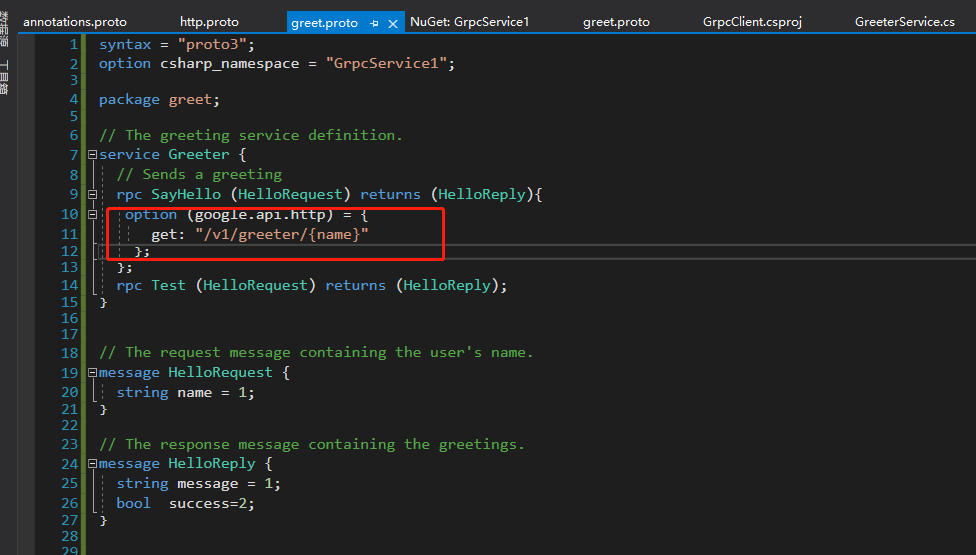
运行程序 然后用浏览器直接调用
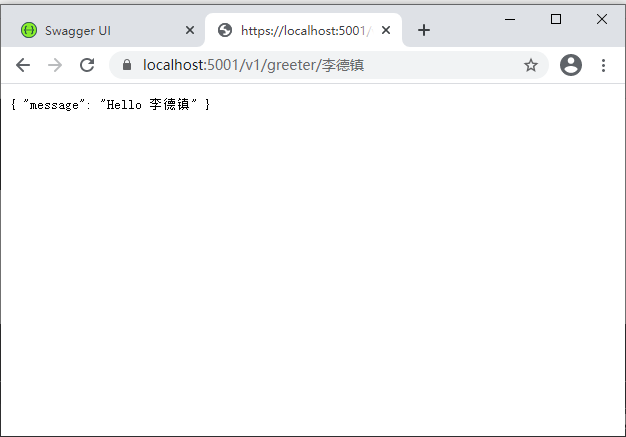
添加swagger,首先添加引用

再startup文件中添加代码
using System; using System.Collections.Generic; using System.Linq; using System.Threading.Tasks; using Microsoft.AspNetCore.Builder; using Microsoft.AspNetCore.Hosting; using Microsoft.AspNetCore.Http; using Microsoft.Extensions.DependencyInjection; using Microsoft.Extensions.Hosting; using Microsoft.OpenApi.Models; namespace GrpcService1 { public class Startup { // This method gets called by the runtime. Use this method to add services to the container. // For more information on how to configure your application, visit https://go.microsoft.com/fwlink/?LinkID=398940 public void ConfigureServices(IServiceCollection services) { services.AddGrpcHttpApi(); services.AddSwaggerGen(c => { c.SwaggerDoc("v1", new OpenApiInfo { Title = "My API", Version = "v1" }); }); services.AddGrpcSwagger(); services.AddGrpc(); } // This method gets called by the runtime. Use this method to configure the HTTP request pipeline. public void Configure(IApplicationBuilder app, IWebHostEnvironment env) { if (env.IsDevelopment()) { app.UseDeveloperExceptionPage(); } // For static content app.UseHttpsRedirection(); app.UseDefaultFiles(); app.UseStaticFiles(); app.UseSwagger(); app.UseSwaggerUI(c => { c.SwaggerEndpoint("/swagger/v1/swagger.json", "My API V1"); }); app.UseRouting(); app.UseEndpoints(endpoints => { endpoints.MapGrpcService<GreeterService>(); //endpoints.MapGet("/", async context => //{ // await context.Response.WriteAsync("Communication with gRPC endpoints must be made through a gRPC client. To learn how to create a client, visit: https://go.microsoft.com/fwlink/?linkid=2086909"); //}); }); } } }
运行程序
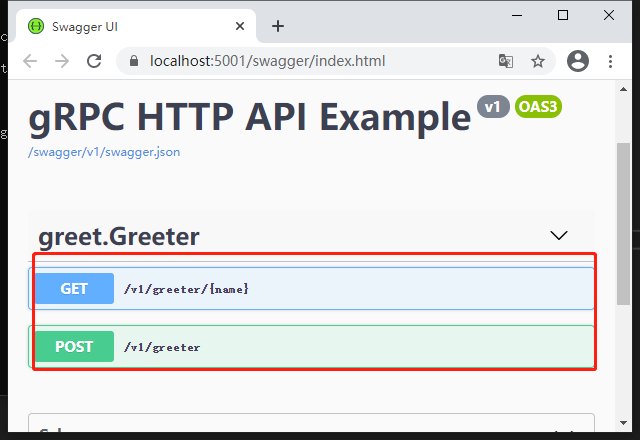
在界面上调用接口

官方文档地址:https://docs.microsoft.com/zh-cn/aspnet/core/grpc/httpapi?view=aspnetcore-3.1
